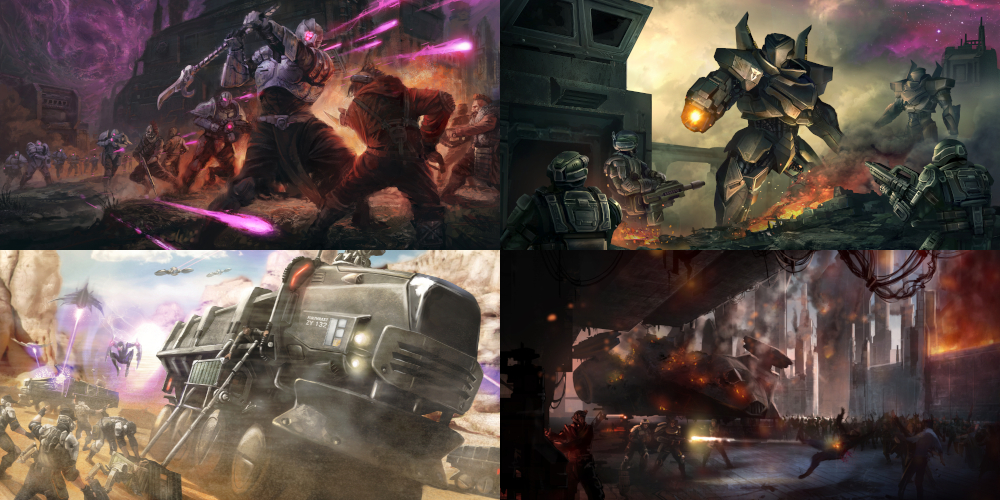Maelstrom's Edge V2 Beta Rules released!
Posted on Monday Dec 20, 2021 at 06:00pm in Gaming
The 2nd edition of the Maelstrom’s Edge rulebook is on its way, and we're offering a sneak preview in the form of a downloadable Beta version of the rules. You can find the link at the end of this article, but you’re probably wondering: what’s changed? Is it a totally new game or just a sprucing up of the v1 rules? The answer is: a little bit of both.
If you’re a big fan of the v1 rules, then you’ll be pleased to know that the core pillars that comprise Maelstrom’s Edge are not only still there, but have been strengthened. It’s still an alternating activation, squad-based “skirmish” game (aka focused on small squads of 1-6 models) that features 6-sided dice (D6), multi-tiered mission objectives, a suppression mechanic, the ability to bring back destroyed units as reinforcements and a regenerating command point system that can be used for a variety of tactical functions.
If, on the other hand, you’re someone that liked the overall concept of the original Maelstrom’s Edge rules, but you thought that the rules were a little too fiddly, then we also have great news for you! The v2 rules have been totally re-written and highly streamlined: they are a good 30% shorter than the v1 rules as a result. While the v2 rules are undeniably simpler, they’ve also gotten more complex where it counts: giving you tons of new tactical decisions to make with your units during the game. On top of that, the dice rolling “engine” now feels really fresh: each round of shooting keeps both players involved rolling dice and utilizes a “dice flip” mechanic that adds an element of bad luck protection right into the core of the game.
Let’s run through some highlights of the major v2 changes:
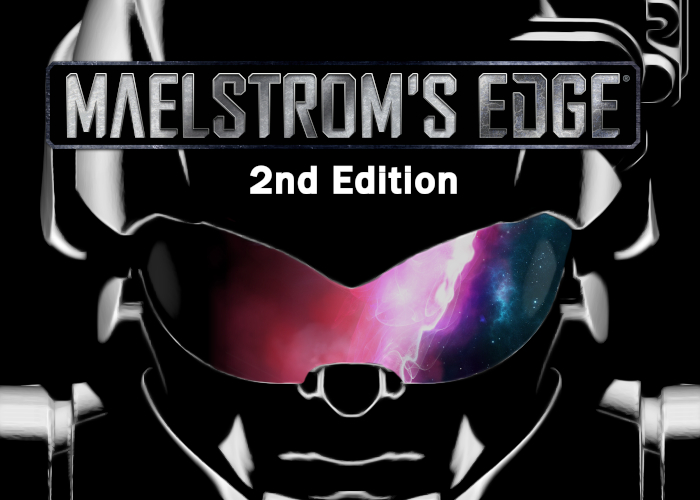
SIMPLIFIED UNIT ACTIONS
The largest change in v2 is how unit actions work. The activation test is gone and a unit can now perform up to 3 actions, selected from: movement actions (Move, Dash, Charge), status actions (Aim, On the Move, Take Cover) and shooting actions (Fire, Suppressive Fire, CQ Fighting). While there are some additional caveats to this system (a unit can perform a maximum of only 1 movement and 1 shooting action per activation, for example), we’ve found during playtesting that by splitting the action rules into these smaller “bite-sized” chunks, it makes the whole system much easier to remember. In addition, decoupling movement, shooting and status rules from each other now gives players several new combinations of what to do with their units when they activate them.
SUPPRESSION THAT MATTERS
In v2, suppression is both much simplified and also a whole heck of a lot more deadly. Instead of utilizing tons of suppression tokens, each unit only has 6 suppression levels (which can be conveniently tracked with a D6 next to the unit). Not only does suppression still degrade a unit’s shooting and their ability to benefit from cover, but each time a unit already at max suppression is called upon to raise their suppression level again, one model in the unit instead suffers an injury (which is fatal for most standard infantry in the game). This means it is now entirely possible to ”suppress” an enemy unit to death, representing them fleeing from the battlefield due to the hail of firepower coming their way. This makes the new Suppressive Fire action (which trades-in a shooting unit’s ability to cause damage for a boosted ability to cause suppression) a deadly tool in certain situations.
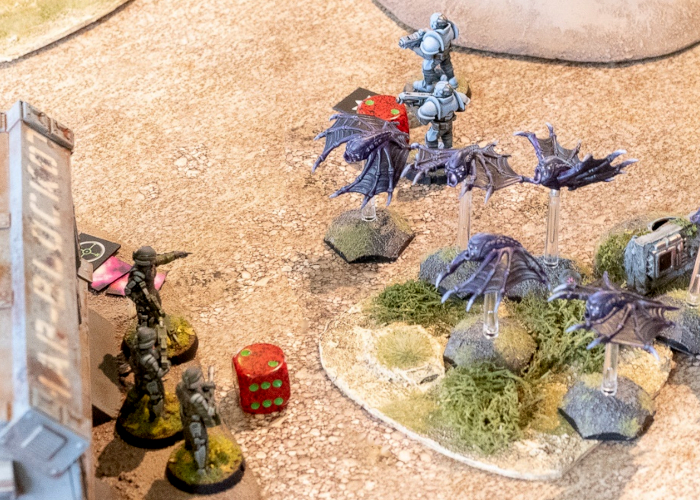
A NEW DICE ENGINE
The new dice rolling engine in v2 is quite unique, but still based exclusively on 6-sided dice that most players prefer. It is both simple enough to quickly understand, yet nuanced enough to offer: built-in bad luck protection, having both players involved with each round of shooting and tactical player choice within the dice rolling process. Most importantly, when units shoot at each other, the amount of damage they cause now just feels right.
So how does the new system work? As a firing player, all you have to do is look to equal or beat the target’s Evasion characteristic (EVS) with your D6 rolls. For example, if the target has an EVS 4 (the standard EVS of most infantry units), you’d need results of 4-6 to successfully hit them. In addition, as the firing player you get to influence these results by making a number of “dice flips” (changing the result of rolls in your favor) up to the Skill characteristic (SKL) of your firing unit. For example, if your firing unit was SKL 3, you could add +3 to a single roll, +1 to 3 different rolls, or anywhere else in between. Where things really get interesting is that results of ‘1’ and ‘6’ are “critical” results. A “critical hit” (a hit roll result of ‘6’) provides that shot with extra lethality. But it also takes 2 dice flips to change a non-critical result into a critical result (a ‘5’ result into a ‘6’). This means sometimes you have to decide whether using 2 dice flips to change a single ‘5’ result into a critical hit will be more beneficial than just using those same dice flips to score two more standard hits.
And of course, once the firing player has determined how many hits they’ve scored on the target, the defending player gets to make an armor roll against each hit, looking to equal or exceed the Penetration characteristic (PEN) of the firing weapon. Similarly, the defending player gets to influence the results of these rolls with a number of dice flips equal to the Armor characteristic (AV) of their models.
FEWER SPECIAL RULES
With v2, we’ve realized that adding back a few more characteristics to the model/weapon profile means a big reduction in the amount of special abilities in the game. Plus, the abilities we have kept have been greatly simplified, all with the end goal of making each unit’s full rules (including all the text for their unit and weapon abilities) fit onto just a single page.
Here’s a quick rundown of the “new” model & weapon characteristics in v2:
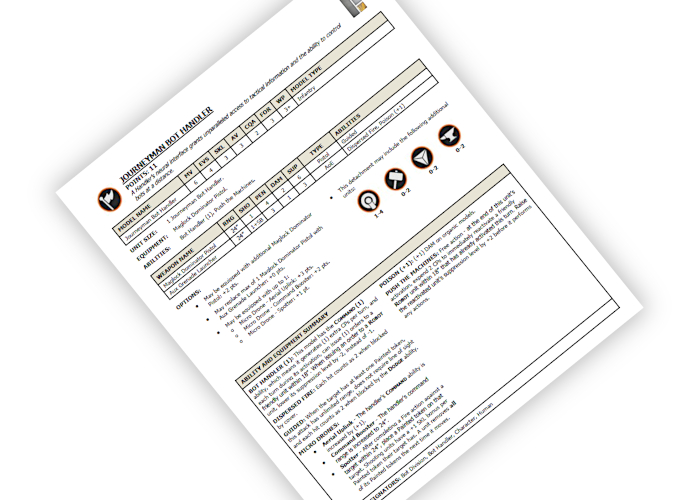
MORE LETHALITY
One goal of the v2 rules has been to improve the level of lethality in the game. Allowing massive amounts of suppression to inflict damage to a unit was a good first step, but the real key to this change has been the removal of the Mass characteristic (MAS) from the model profile. Now, each point of damage a model suffers just reduces their Fortitude (FOR) characteristic by 1 (and when a model reaches 0 FOR, it is a casualty). The vast majority of standard infantry models only have FOR 1, which means that any hit which gets through their armor will cause a casualty. While this doesn’t suddenly mean that models are now dying in droves in v2, we can safely say that you will notice and appreciate the increase in lethality in the game. You’ll definitely want to start using the reinforcement rules more often to bring back your destroyed units!
QUALITY OF LIFE IMPROVEMENTS
The v2 rules are chock full of little improvements that make the game feel way better overall. Here’s a taste of them:
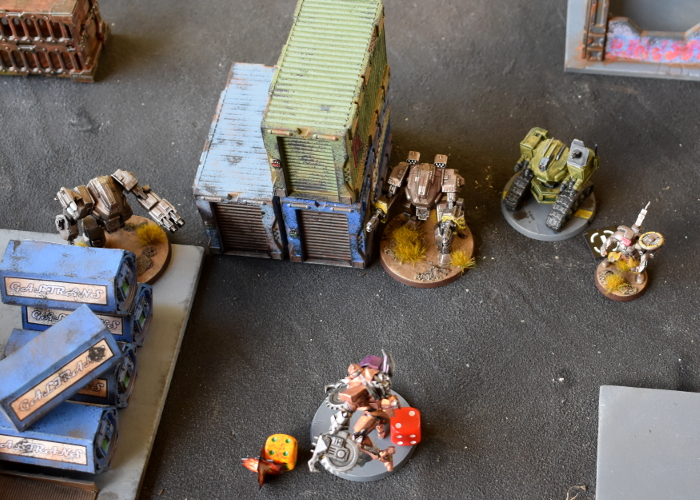
IN CONCLUSION
As you can see, the new rules for Maelstrom’s Edge are chock full of improvements...and none of what we’ve presented above even covers the massive rules re-work we’ve done for every single unit in the game. Their rules are both far more streamlined but also laser-focused on allowing them to perform exactly how they’re supposed to. It’s been an extremely long time coming, but we can’t wait for you to try out the new rules and let us know what you think!
The new rulebook will be coming along (hopefully!) in the first half of 2022, but you can get a headstart on the V2 ruleset by downloading a Beta version of the rules here. The Beta rules documents contains all of the rules for playing the game, but keep in mind that these are just 'preview' documents - some rules may be revised based on feedback, and the final layout including background material for the factions and the Maelstrom's Edge universe, artwork and other 'flavor' material is missing.
If you have any thoughts on the new rules, you can pop on over to the Comm Guild Facebook group, or start up a thread in the Maelstrom's Edge section on the Dakka Dakka forums. We welcome any feedback, and would love to hear how everyone's forces stack up in the new rules!
If you’re a big fan of the v1 rules, then you’ll be pleased to know that the core pillars that comprise Maelstrom’s Edge are not only still there, but have been strengthened. It’s still an alternating activation, squad-based “skirmish” game (aka focused on small squads of 1-6 models) that features 6-sided dice (D6), multi-tiered mission objectives, a suppression mechanic, the ability to bring back destroyed units as reinforcements and a regenerating command point system that can be used for a variety of tactical functions.
If, on the other hand, you’re someone that liked the overall concept of the original Maelstrom’s Edge rules, but you thought that the rules were a little too fiddly, then we also have great news for you! The v2 rules have been totally re-written and highly streamlined: they are a good 30% shorter than the v1 rules as a result. While the v2 rules are undeniably simpler, they’ve also gotten more complex where it counts: giving you tons of new tactical decisions to make with your units during the game. On top of that, the dice rolling “engine” now feels really fresh: each round of shooting keeps both players involved rolling dice and utilizes a “dice flip” mechanic that adds an element of bad luck protection right into the core of the game.
Let’s run through some highlights of the major v2 changes:

SIMPLIFIED UNIT ACTIONS
The largest change in v2 is how unit actions work. The activation test is gone and a unit can now perform up to 3 actions, selected from: movement actions (Move, Dash, Charge), status actions (Aim, On the Move, Take Cover) and shooting actions (Fire, Suppressive Fire, CQ Fighting). While there are some additional caveats to this system (a unit can perform a maximum of only 1 movement and 1 shooting action per activation, for example), we’ve found during playtesting that by splitting the action rules into these smaller “bite-sized” chunks, it makes the whole system much easier to remember. In addition, decoupling movement, shooting and status rules from each other now gives players several new combinations of what to do with their units when they activate them.
SUPPRESSION THAT MATTERS
In v2, suppression is both much simplified and also a whole heck of a lot more deadly. Instead of utilizing tons of suppression tokens, each unit only has 6 suppression levels (which can be conveniently tracked with a D6 next to the unit). Not only does suppression still degrade a unit’s shooting and their ability to benefit from cover, but each time a unit already at max suppression is called upon to raise their suppression level again, one model in the unit instead suffers an injury (which is fatal for most standard infantry in the game). This means it is now entirely possible to ”suppress” an enemy unit to death, representing them fleeing from the battlefield due to the hail of firepower coming their way. This makes the new Suppressive Fire action (which trades-in a shooting unit’s ability to cause damage for a boosted ability to cause suppression) a deadly tool in certain situations.

A NEW DICE ENGINE
The new dice rolling engine in v2 is quite unique, but still based exclusively on 6-sided dice that most players prefer. It is both simple enough to quickly understand, yet nuanced enough to offer: built-in bad luck protection, having both players involved with each round of shooting and tactical player choice within the dice rolling process. Most importantly, when units shoot at each other, the amount of damage they cause now just feels right.
So how does the new system work? As a firing player, all you have to do is look to equal or beat the target’s Evasion characteristic (EVS) with your D6 rolls. For example, if the target has an EVS 4 (the standard EVS of most infantry units), you’d need results of 4-6 to successfully hit them. In addition, as the firing player you get to influence these results by making a number of “dice flips” (changing the result of rolls in your favor) up to the Skill characteristic (SKL) of your firing unit. For example, if your firing unit was SKL 3, you could add +3 to a single roll, +1 to 3 different rolls, or anywhere else in between. Where things really get interesting is that results of ‘1’ and ‘6’ are “critical” results. A “critical hit” (a hit roll result of ‘6’) provides that shot with extra lethality. But it also takes 2 dice flips to change a non-critical result into a critical result (a ‘5’ result into a ‘6’). This means sometimes you have to decide whether using 2 dice flips to change a single ‘5’ result into a critical hit will be more beneficial than just using those same dice flips to score two more standard hits.
And of course, once the firing player has determined how many hits they’ve scored on the target, the defending player gets to make an armor roll against each hit, looking to equal or exceed the Penetration characteristic (PEN) of the firing weapon. Similarly, the defending player gets to influence the results of these rolls with a number of dice flips equal to the Armor characteristic (AV) of their models.
FEWER SPECIAL RULES
With v2, we’ve realized that adding back a few more characteristics to the model/weapon profile means a big reduction in the amount of special abilities in the game. Plus, the abilities we have kept have been greatly simplified, all with the end goal of making each unit’s full rules (including all the text for their unit and weapon abilities) fit onto just a single page.
Here’s a quick rundown of the “new” model & weapon characteristics in v2:
- The model profile has lost its Mass characteristic (MAS), but has gained the Close Quarters Attacks characteristic (CQA) instead, rectifying the biggest point of negative feedback we got about the v1 rules: the much maligned ‘formula’ that was necessary to determine how many melee shots a model was able to make.
- The weapon profile has gained a Suppression characteristic (SUP), which is utilized when the unit makes a Suppressive Fire action.
- The weapon profile has gained a Weapon Type characteristic (TYPE), which helps set apart the archetypal weapon rules (like “AoE”, “Heavy” or “Short Ranged”) from true weapon special abilities.

MORE LETHALITY
One goal of the v2 rules has been to improve the level of lethality in the game. Allowing massive amounts of suppression to inflict damage to a unit was a good first step, but the real key to this change has been the removal of the Mass characteristic (MAS) from the model profile. Now, each point of damage a model suffers just reduces their Fortitude (FOR) characteristic by 1 (and when a model reaches 0 FOR, it is a casualty). The vast majority of standard infantry models only have FOR 1, which means that any hit which gets through their armor will cause a casualty. While this doesn’t suddenly mean that models are now dying in droves in v2, we can safely say that you will notice and appreciate the increase in lethality in the game. You’ll definitely want to start using the reinforcement rules more often to bring back your destroyed units!
QUALITY OF LIFE IMPROVEMENTS
The v2 rules are chock full of little improvements that make the game feel way better overall. Here’s a taste of them:
- Command points no longer need to be allocated to command models. They just stay in your command point pool until you decide to use them.
- More command models have powerful abilities that cost command points to use, giving you further options for what to use your command points on (besides the mainstays of bringing back reinforcements and lowering suppression on your units). But don’t worry, we haven’t gone overboard and given every unit a Command Point based ability, these are still quite special.
- When moving your units, you now only have to bother measuring and moving the unit’s squad leader. The rest of the models are just placed in coherency (within 3” of the squad leader) after their squad leader has finished being moved. This dramatically speeds up the process of moving units.
- The v1 rules deliberately syphoned almost every non-damage effect down to just generating additional suppression, which made special abilities feel, well, not so special. With v2, we’ve expanded the range of what special abilities can do (and we’ll eventually be releasing a set of plastic tokens to help facilitate this). Be prepared to be able to set units on fire, slow them down, freeze them and confuse them, just to name a few options.
- To promote unit movement, defensive fire in v2 has been reduced to just protecting a unit from being charged or shot by a hit and run attack. This means units equipped with Short Ranged weaponry can finally shine, being able to run up to enemy units and blast them at point blank range without fear of being decimated first.
- The way mission objectives generate victory points (VPs) has been simplified, making it much easier to calculate how many VPs you’ve earned at the end of each turn. In addition, the margin you need to be ahead of your opponent to end the game immediately has been widened for all missions, now requiring a +5 VP margin. This gives a little more breathing room for close games to go the distance while still allowing for blowouts to end without one player having to bite the bullet and concede.
- There are now 18 types of mission objectives (up from 12) and 6 different deployment maps (up from 2). There are also now 12 competitive missions and 6 narrative missions included with the core rulebook (up from 6 & 0 respectively). All this means there is now a whole lot more mission variety in v2!
- There is a fun new objective marker placement rule forcing you to place objective markers in the opposing half of the table (and your opponent is bound by the same rule). This helps create tense, interesting games where both sides are fighting over objective markers clustered near the centerline of the table, as opposed to one player getting lucky and having one random objective marker near their deployment zone granting them an easy victory.

IN CONCLUSION
As you can see, the new rules for Maelstrom’s Edge are chock full of improvements...and none of what we’ve presented above even covers the massive rules re-work we’ve done for every single unit in the game. Their rules are both far more streamlined but also laser-focused on allowing them to perform exactly how they’re supposed to. It’s been an extremely long time coming, but we can’t wait for you to try out the new rules and let us know what you think!
The new rulebook will be coming along (hopefully!) in the first half of 2022, but you can get a headstart on the V2 ruleset by downloading a Beta version of the rules here. The Beta rules documents contains all of the rules for playing the game, but keep in mind that these are just 'preview' documents - some rules may be revised based on feedback, and the final layout including background material for the factions and the Maelstrom's Edge universe, artwork and other 'flavor' material is missing.
If you have any thoughts on the new rules, you can pop on over to the Comm Guild Facebook group, or start up a thread in the Maelstrom's Edge section on the Dakka Dakka forums. We welcome any feedback, and would love to hear how everyone's forces stack up in the new rules!
Like this? Like us on facebook to see more...
